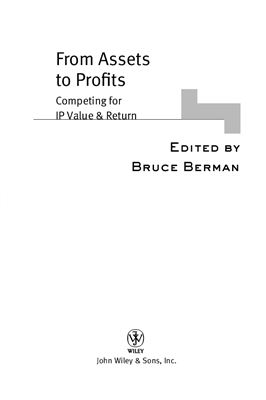Издательство John Wiley, 2009, -322 pp.
Innovation profoundly affects every business and investor. While most executives believe that new ideas are the currency of choice, few agree on the best ways to profit from them. From Ideas to Profits is a search for how invention rights become business assets and the ways they can be converted into retu.
Along the way, contributors to this book confront questions facing managers and businesses who rely on innovation. These questions include: When do IP rights like patents become business assets? What are the best business models for an IP holder to achieve retu or advantage?
Who in fact, are IP investors and how do they affect innovation? IP value typically escapes the balance sheet. Revenues from patent licenses are attractive to some because they are easily understood. But royalty generation is one of many ways intellectual assets can be monetized. It is not the definitive way. Many companies under pressure to perform get sucked into the competition to build patent stockpiles and generate fees. Some have called licensing income an addiction; a mythological siren song that seduces otherwise intelligent CEOs and financial analysts.
Retu on intellectual assets means different things to different IP holders. The dynamics of deploying invention rights have changed dramatically over the past twenty years and there is a burden on patent owners today to extract meaningful retus on high cost of R&D. This is especially true of operating companies that are engaged in selling products as opposed to licensing them. It is difficult to pinpoint the role IP rights play in protecting products’ market share or maintaining their profit margins. It is even more difficult to capture their impact on overall business performance. A company may know that some of its patents vaguely support objectives, but seldom can it measure their impact on profitability, the lifeblood of a company.
Part one IP Business Models 1
Out of Alignment —Getting IP and Business Strategies Back in Sync
Evolution of the Technology Firm: IP Rights and the Business of Licensing
Reengineering the IP Ecosystem
IP Investing: Catalyst for Retu or Recipe for Pain?
Making Sense of Recent Trends, Court Decisions, and Attempts at Patent Reform
Part two IP Performance 103
Patent Valuation Contexts: Navigating Murky Waters
Measuring and Conveying IP Value in the Global Enterprise
Strategic Patents and Retu on Investment
Patent Litigation: The Changing Economics of Risk & Retu
Making Reputation Pay: Intellectual Assets’ Impact on Shareholder Value
Part three IP Transactions
IP Asset Sales, Still A Work in Progress
The Evolving Role of IP in M&A: From Deal-Breaker to Deal-Maker
Patents-as-Hedge: Wall Street’s Emerging Monetization Model
Financing IP Assets—What Lenders and Investors are Missing
Assets, Property and Capital in a Globalized Intellectual Value Chain
Innovation profoundly affects every business and investor. While most executives believe that new ideas are the currency of choice, few agree on the best ways to profit from them. From Ideas to Profits is a search for how invention rights become business assets and the ways they can be converted into retu.
Along the way, contributors to this book confront questions facing managers and businesses who rely on innovation. These questions include: When do IP rights like patents become business assets? What are the best business models for an IP holder to achieve retu or advantage?
Who in fact, are IP investors and how do they affect innovation? IP value typically escapes the balance sheet. Revenues from patent licenses are attractive to some because they are easily understood. But royalty generation is one of many ways intellectual assets can be monetized. It is not the definitive way. Many companies under pressure to perform get sucked into the competition to build patent stockpiles and generate fees. Some have called licensing income an addiction; a mythological siren song that seduces otherwise intelligent CEOs and financial analysts.
Retu on intellectual assets means different things to different IP holders. The dynamics of deploying invention rights have changed dramatically over the past twenty years and there is a burden on patent owners today to extract meaningful retus on high cost of R&D. This is especially true of operating companies that are engaged in selling products as opposed to licensing them. It is difficult to pinpoint the role IP rights play in protecting products’ market share or maintaining their profit margins. It is even more difficult to capture their impact on overall business performance. A company may know that some of its patents vaguely support objectives, but seldom can it measure their impact on profitability, the lifeblood of a company.
Part one IP Business Models 1
Out of Alignment —Getting IP and Business Strategies Back in Sync
Evolution of the Technology Firm: IP Rights and the Business of Licensing
Reengineering the IP Ecosystem
IP Investing: Catalyst for Retu or Recipe for Pain?
Making Sense of Recent Trends, Court Decisions, and Attempts at Patent Reform
Part two IP Performance 103
Patent Valuation Contexts: Navigating Murky Waters
Measuring and Conveying IP Value in the Global Enterprise
Strategic Patents and Retu on Investment
Patent Litigation: The Changing Economics of Risk & Retu
Making Reputation Pay: Intellectual Assets’ Impact on Shareholder Value
Part three IP Transactions
IP Asset Sales, Still A Work in Progress
The Evolving Role of IP in M&A: From Deal-Breaker to Deal-Maker
Patents-as-Hedge: Wall Street’s Emerging Monetization Model
Financing IP Assets—What Lenders and Investors are Missing
Assets, Property and Capital in a Globalized Intellectual Value Chain

